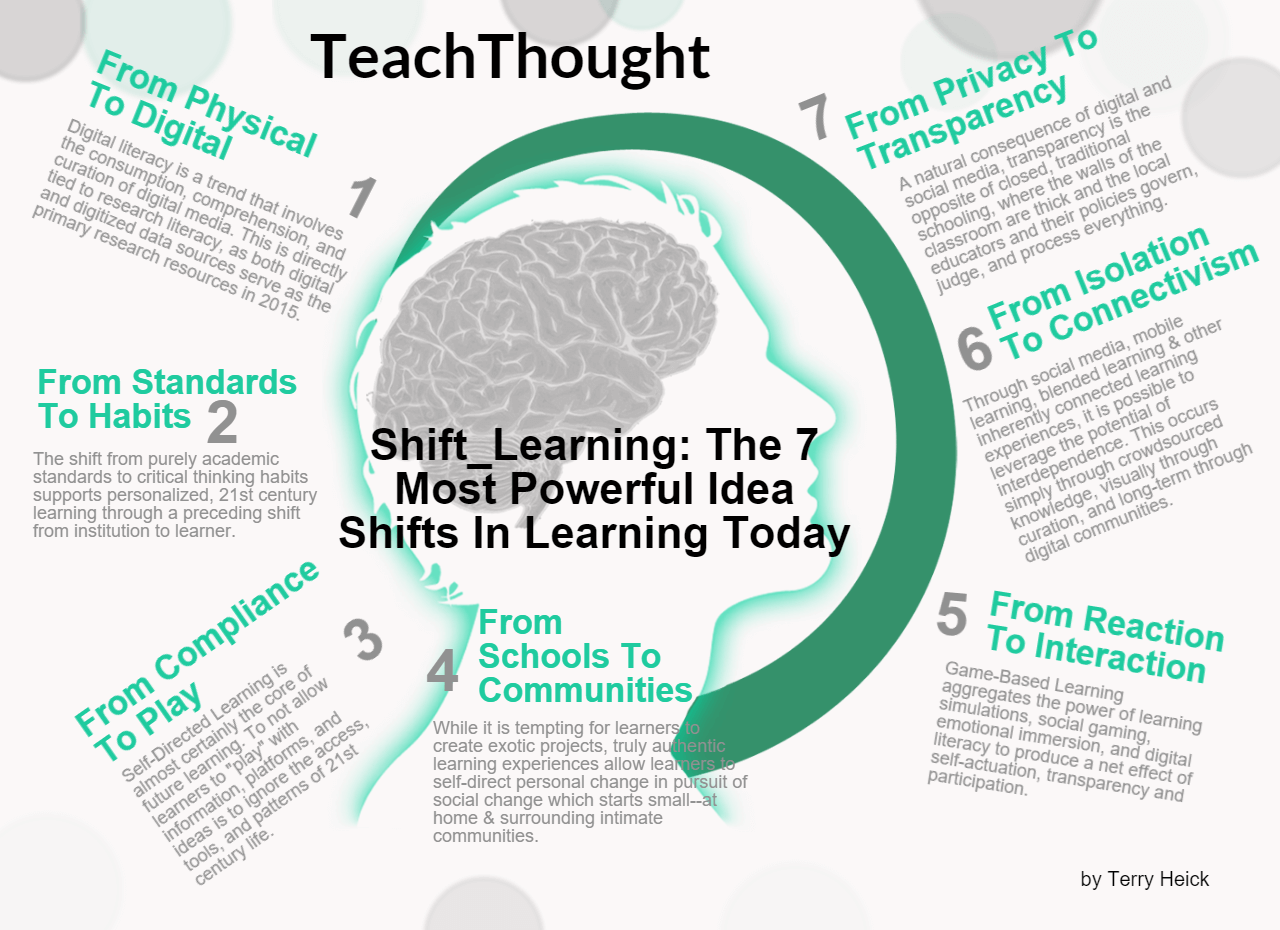
What Shifts Will Help Expedite Tomorrow’s Learning To Today?
by Terry Heick
This post was written in 2014 and updated in 2019
Let’s take a look at this vague idea of the ‘classroom of the future.’ This is all subjective, but it’s worth talking about. So let’s talk.
Below are some ideas that are truly transformational–not that they haven’t been said before. It’s not this article that’s transformational, but the ideas themselves. These ideas aren’t just buzzwords or trendy edu-jargon but the kind of substance with the potential for lasting change.
And the best part? This is stuff that’s available not tomorrow with $10,000 in funding and 12 hours of summer PD, but today. Utopian visions of learning are tempting, if for no other reason than they absolve us of accountability to create it right now, leading to nebulous romanticizing about how powerful learning could be if we just did more of X and Y.
But therein lies the rub: Tomorrow’s learning is already available, and below are seven of the most compelling and powerful trends, concepts, and resources that represent its promise.
The Challenge of Implementation
It’s challenging enough to manage a traditional learning environment where the curriculum is handed to you, and meetings are set, and you’re simply there to manage; adding more ingredients to the mix seems like asking for trouble. But the truth is, it’s becoming increasingly difficult to educate children in the face of such radical technological and pedagogical progression.
The good news is, many of the elements of a progressive learning environment—e.g., digital literacy, connectivism, and play—conveniently, and not coincidentally, work together. And better yet, collectively they can reduce the burden on those managing the learning because they place the learner at the center.
While it’s possible to tack these ideas on to a traditional classroom, and then sit back and wait for the clouds to part and the sun to shine brilliantly, you’ll likely be waiting a while. These aren’t single tools to try but new ways to think about how learners access media, how educators define success, and what the roles of immense digital communities should be in popularizing new learning models.
None of it is really complicated—it just requires new thinking.
Tomorrow’s Learning Today: 7 Shifts Of Future Learning
1. Digital As Supplement –> Digital As Standard
Which means new literacies.
It’s not so much that physical is ‘out’ and digital is ‘in’ but that the sheer scale and accessibility of digital resources, connections, and spaces are overwhelming; if in no other place other than the mindscape of the student, when it comes to reading, writing, communicating, saving, creating, and sharing, digital is everything.
Even ‘school’ ideas like literacy are all different now. Digital literacy is a trend that involves the consumption, comprehension, and curation of digital media. This is directly tied to research literacy, as both digital and digitized data sources serve as primary research resources.
2. Standards –> Habits
This is among the biggest and most powerful ideas in ‘future learning,’ and should be central to any meaningful discussion therein. What are students learning, why are they learning it, and what are they doing with what they know? In short, the shift from purely academic standards to critical thinking habits supports personalized, 21st-century learning through a preceding shift from institution to learner.
3. Single-Media Text –> Blended Modalities
The traditional modalities of learning are single-media text–pencils and papers and books and pictures. In the classroom of the future, the shift will be toward blended modalities–videos (e.g., YouTube), audio files (e.g., podcasts), augmented reality, virtual reality, haptic feedback, and of course, games.
Game-Based Learning aggregates the power of learning simulations, social gaming, emotional immersion, and digital literacy to produce a net effect of transparency and participation on the learner.
4. Individualism–> Connectivism
Through social media, mobile learning, blended learning, eLearning, and other inherently connected learning experiences, it is possible to leverage the potential of interdependence and crowds. This occurs simply through crowdsourced knowledge (e.g., Quora, Wikipedia), visually through curation (e.g., scoopit, pinterest), and long-term through digital communities (e.g., YouTube, DIY, etc.)
5. Physical Classroom –> Invisible Classroom & Transparency
A natural consequence of digital and social media, transparency is the opposite of closed, traditional schooling, where the walls of the classroom are tick and the local teachers and policies govern, judge, and process everything.
Increasingly personalized learning and learner mobility will be a part of this shift (as well as the shift below to a larger emphasis on Learning Spaces And Places.
6. Academics And Standards –> Spaces And Places (and networks)
Spaces and places matter. What are they learning, and why? Add to that, where are they taking that knowledge to use?
Place-Based Education complements digital platforms that tend towards globalization. While it is tempting for learners to constantly connect with exotic ideas in equally exotic locations, authentic learning experiences allow learners to self-direct personal change in pursuit of social change–and that starts small, at home, and surrounding intimate communities.
7. Teacher-Led Learning –> Self-Directed Learning
Self-Directed Learning is almost certainly at the core of the future of learning. To not allow learners to ‘play’ with information, platforms, and ideas is to ignore the access, tools, and patterns of 21st-century life.